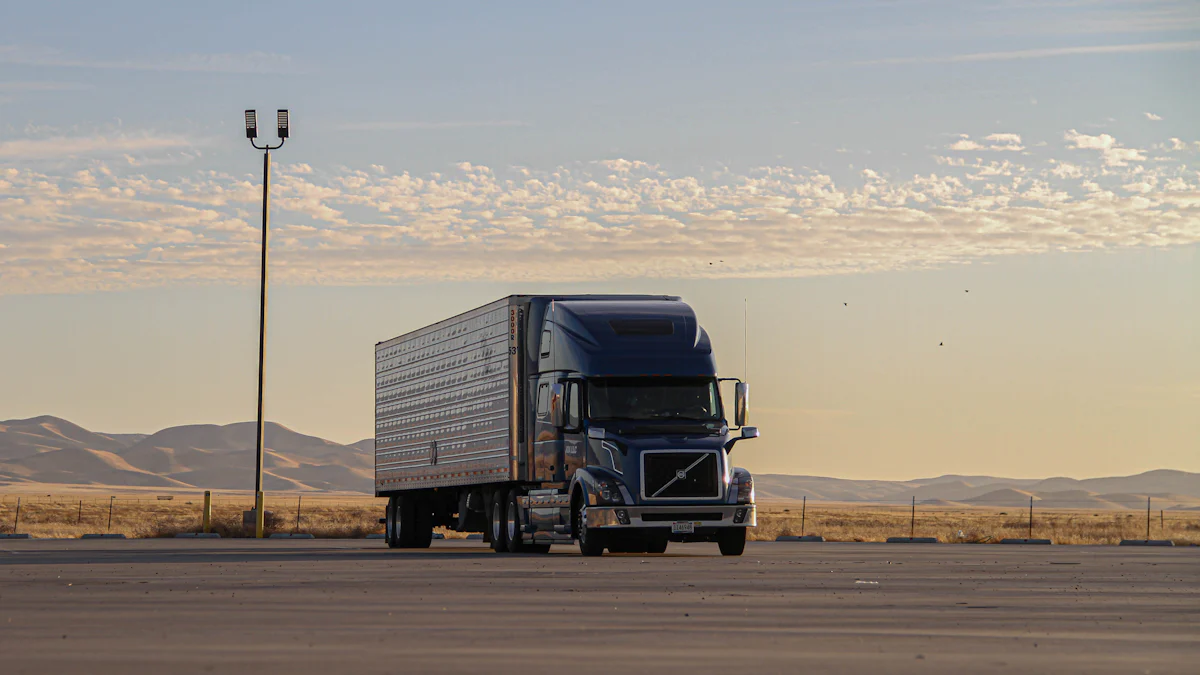Domestic Trucking: Comparing Efficiency and Cost

Domestic trucking refers to the transportation of goods within a country's borders using trucks. Efficiency and cost play crucial roles in this industry. Efficient operations ensure timely deliveries and optimal resource use. Cost management impacts profitability and competitiveness. This comparison blog post will explore how efficiency and cost influence domestic trucking, providing valuable insights for making informed decisions.
Understanding Domestic Trucking
Definition and Scope
What is Domestic Trucking?
Domestic trucking involves transporting goods within a country's borders using trucks. This method ensures goods move efficiently from manufacturers to consumers. Domestic trucking plays a vital role in the supply chain. Trucks handle a significant portion of freight transportation.
Scope of Domestic Trucking in the U.S.
The scope of domestic trucking in the U.S. is extensive. Trucks move roughly 72.6% of the nation's freight by weight. The industry includes various services like traditional trucking and domestic intermodal transportation. The market size reached USD 2,856.73 billion in 2022. Projections indicate growth to USD 5,530.97 billion by 2032.
Key Components
Types of Trucks Used
Different types of trucks serve various purposes in domestic trucking. Common types include:
Dry Vans: These trucks transport non-perishable goods.
Flatbeds: These trucks carry oversized or irregularly shaped items.
Refrigerated Trucks: These trucks keep perishable goods at specific temperatures.
Tankers: These trucks transport liquids and gases.
Each type of truck meets specific needs. This variety ensures efficient transportation for all kinds of goods.
Major Players in the Industry
Several companies dominate the domestic trucking industry. Some notable players include:
Gulf Winds International, Inc.: A leader in drayage, transloading, and domestic freight.
Foodliner: Partners with Drive My Way to hire CDL A Regional and Local Liquid and Dry Bulk Drivers.
Old Dominion Freight Line: Known for reliable freight services.
Paschall Truck Lines: Offers comprehensive trucking solutions.
USA Truck (DB Schenker): Provides extensive domestic trucking services.
Dayton Freight Lines: Specializes in regional freight transportation.
J.B. Hunt Transport Services: A major player in logistics and transportation.
These companies ensure goods reach their destinations efficiently. Their services contribute significantly to the U.S. economy.
Efficiency in Domestic Trucking

Factors Affecting Efficiency
Fuel Consumption
Fuel consumption plays a significant role in trucking efficiency. Trucks require substantial fuel, and fuel prices fluctuate. Companies aim to reduce fuel usage to save money and lower emissions. Investing in gas-efficient vehicles helps achieve this goal. Training drivers on fuel-saving techniques also makes a difference.
Route Optimization
Route optimization ensures trucks take the best paths. Efficient routes save time and fuel. Companies use advanced software for this purpose. These tools analyze traffic patterns and road conditions. Optimized routes lead to timely deliveries and cost savings. JUSDA Logistic Technology excels in this area by tailoring routes to minimize expenses.
Technological Advancements
Technological advancements revolutionize the trucking industry. Real-time data tools provide valuable insights. Load optimization software maximizes truck capacity. These technologies streamline operations and reduce costs. JUSDA focuses on sustainable practices and cost-effective logistics solutions. Their innovative approach includes reducing carbon emissions and enhancing service quality.
Measuring Efficiency
Time Management
Time management is crucial for trucking efficiency. Efficient scheduling ensures timely deliveries. Companies monitor driver hours and rest periods. This practice prevents delays and maintains safety standards. JUSDA's real-time collaborative platforms support precise business decision-making. These tools help manage time effectively.
Resource Utilization
Resource utilization involves making the best use of available assets. Proper maintenance keeps trucks in good condition. Regular checks prevent breakdowns and costly repairs. Efficient resource utilization extends vehicle lifespan. JUSDA's approach includes integrating suppliers, manufacturers, and service providers. This integration enhances overall efficiency and reliability.
Cost Analysis in Domestic Trucking

Breakdown of Costs
Fuel Costs
Fuel costs represent a significant portion of trucking expenses. Trucks require large amounts of fuel to operate. Fuel prices fluctuate frequently, impacting overall costs. Investing in gas-efficient vehicles can help reduce these expenses. Many companies now focus on sustainability initiatives. Electric trucks and cleaner fuels are becoming more popular in the industry.
Maintenance and Repairs
Maintenance and repairs are crucial for keeping trucks in good condition. Regular maintenance prevents breakdowns and costly repairs. Companies must budget for routine checks and unexpected fixes. Proper maintenance extends the lifespan of vehicles. This practice also ensures safety and reliability on the road.
Labor Costs
Labor costs include wages for drivers and other staff. The trucking industry faces challenges with driver shortages. Companies often offer competitive salaries to attract and retain drivers. Training programs also add to labor costs. Efficient scheduling and route planning can help manage these expenses.
Cost-Saving Strategies
Efficient Route Planning
Efficient route planning saves time and fuel. Advanced software helps companies find the best routes. These tools analyze traffic patterns and road conditions. Optimized routes lead to timely deliveries and cost savings. JUSDA Logistic Technology excels in this area by tailoring routes to minimize expenses.
Regular Maintenance
Regular maintenance keeps trucks running smoothly. Scheduled checks prevent major issues and reduce repair costs. Companies should invest in quality parts and skilled technicians. Proper maintenance also improves fuel efficiency. This practice contributes to overall cost savings.
Use of Technology
Technology plays a vital role in reducing costs. Real-time data tools provide valuable insights. Load optimization software maximizes truck capacity. These technologies streamline operations and cut expenses. JUSDA focuses on sustainable practices and cost-effective logistics solutions. Their innovative approach includes reducing carbon emissions and enhancing service quality.
Comparative Analysis: Efficiency vs. Cost
Advantages of Focusing on Efficiency
Long-term Savings
Focusing on efficiency can lead to significant long-term savings. Efficient operations reduce fuel consumption and maintenance costs. Companies that invest in gas-efficient vehicles and regular maintenance see fewer breakdowns. These practices extend the lifespan of trucks and lower overall expenses. Efficient route planning also helps save money by reducing fuel use and travel time.
Improved Customer Satisfaction
Efficiency directly impacts customer satisfaction. Timely deliveries build trust and reliability. Customers appreciate consistent service and punctuality. Efficient operations ensure goods arrive on schedule, meeting customer expectations. Real-time data tools and load optimization software enhance service quality. JUSDA's innovative approach includes reducing carbon emissions and improving logistics solutions, which further boosts customer satisfaction.
Advantages of Focusing on Cost
Immediate Financial Relief
Focusing on cost provides immediate financial relief. Companies can cut expenses by choosing cost-effective methods. Lowering labor costs and using cheaper fuel options help manage budgets. Investing in gas-efficient vehicles may seem expensive initially, but it saves money in the long run. Companies can also explore alternative fuels to reduce costs.
Competitive Pricing
Cost-focused strategies enable competitive pricing. Lower operational costs allow companies to offer better rates. Competitive pricing attracts more customers and increases market share. Companies that manage costs effectively can provide affordable services without compromising quality. This approach helps maintain a strong position in the market.
Balancing Efficiency and Cost
Case Studies
Case Study: Highway Improvements and Logistics Restructuring Transportation improvements can boost productivity. Reduced bottlenecks and increased flexibility enhance logistics operations. Improved access and specialization lead to better market reach. For example, highway improvements have helped specific firms increase productivity. These changes reflect the benefits of balancing efficiency and cost.
Case Study: JUSDA's Technological Advancements JUSDA uses real-time collaborative platforms to optimize routes. The JusLink platform integrates suppliers, manufacturers, and service providers. This integration enhances resource utilization and decision-making. JUSDA's approach demonstrates how technology can balance efficiency and cost. Their focus on sustainable practices reduces expenses and improves service quality.
Best Practices
Balancing efficiency and cost requires strategic planning. Companies should invest in gas-efficient vehicles and regular maintenance. Efficient route planning saves time and fuel. Using advanced software for load optimization maximizes truck capacity. Training drivers on fuel-saving techniques also contributes to cost savings. Companies should adopt sustainable practices to reduce expenses and improve service quality. JUSDA's innovative approach serves as a model for balancing efficiency and cost.
Domestic trucking requires a balance between efficiency and cost. Efficient operations ensure timely deliveries and optimal resource use. Cost management impacts profitability and competitiveness. Companies must master both to thrive.
Balancing efficiency with resource utilization is key. Efficient route planning and regular maintenance reduce costs.
Making informed decisions based on individual needs is crucial. Each company has unique requirements. Consider all factors to achieve the best results.
See Also
Affordable Transportation Management: Your Budget's Greatest Ally
Efficiency Redefined: JUSDA's Logistics Streamlining
Supply Chain Cost Optimization: The Economics Unveiled
Indigenous Intelligent Transport Solutions: Redefining Efficiency
Unleashing Logistics Savings: Supply Chain Efficiency Insights
